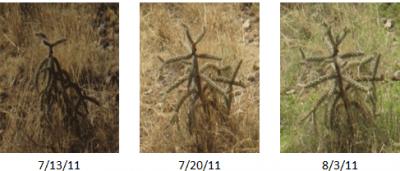Sep 26 2013
A new technique for panoramic, very-high-resolution, time-lapse photography for plant and ecosystem research
 Frames from a GigaPan time-lapse sequence showing vegetation changes induced by summer monsoon season precipitation. The three images, which demonstrate the level of image detail capture allowed by the GigaPan system, show the response of a cholla cactus to precipitation over a 22-day period. Credit: Image courtesy of Nichols et al.
Frames from a GigaPan time-lapse sequence showing vegetation changes induced by summer monsoon season precipitation. The three images, which demonstrate the level of image detail capture allowed by the GigaPan system, show the response of a cholla cactus to precipitation over a 22-day period. Credit: Image courtesy of Nichols et al.
Ever wonder what plants do when you're not around? How about an entire forest or grassland? Not even the most dedicated plant researcher can be continuously present to track environmental effects on plant behavior, and so numerous tools have been developed to measure and quantify these effects. Time-lapse photography has been used to study many aspects of plant behavior, but typically only a few plants can be captured with a single camera at the desired level of detail. This limitation has, for the most part, confined such observations to the laboratory.
Recently, however, researchers have maximized both the scale and resolution of time-lapse photography with the use of a novel robotic camera mount and software—enabling the detailed visualization of plant movements across a wide panoramic view. This system greatly improves the utility of time-lapse photography by capturing interactions between the environment and a plant population in a single sequence. The new technique is demonstrated in the September issue of Applications in Plant Sciences (available for free viewing at http://www.bioone.org/doi/pdf/10.3732/apps.1300033).
"The beauty of time-lapse is that we can make observations in the plant's time scale. Changes in the habitat can be correlated with changes in the plant itself," notes coauthor Janet Steven.
Developed by Randy Sargent and colleagues at the Robotics Institute, Carnegie Mellon University, the GigaPan EPIC Pro is a robotic camera system that makes it possible to create time-lapse sequences of panoramas that also allow the viewer to zoom in at an incredible level of detail, e.g., from a landscape view to that of an individual plant. Environmental responses can be seen across a large population with the additional advantage of examining individual responses within the same population using one time-lapse sequence.
In the current study, Mary Nichols (of the U.S. Department of Agriculture–Agricultural Research Service) and colleagues demonstrated the technique in both indoor and outdoor settings. Using a robotic mount, high-resolution images were captured across a panorama and stitched together with software developed by Sargent and colleagues (available through http://wiki.gigapan.org/creating-time-machines). The researchers chose to use a practical and affordable camera (the Canon G10) to demonstrate the feasibility of the technique to a variety of users.
The indoor setup created a panorama three photos high by seven photos wide of a time-lapse sequence of a quick-growing variety of Brassica rapa plants. This panorama of 21 photos was captured at 15-minute intervals for 21 days. Changes among the plants can be seen as they respond to cabbage white butterfly caterpillars and stinkbugs introduced during the experiment. The helical movements, or circumnutation, of the plants is also evident.
The outdoor setup was powered by solar panels and photographed an Arizona grassland in a panorama four photos high by seven photos wide. These 28 pictures were taken every two hours for nearly one month. The rapid greening response of the grassland to rainfall is easily seen as well as the response of an individual cholla cactus as its branches become erect due to the rainfall.
The study describes the new technique in detail and provides a materials listing, costs, and example sources for components to build the solar-powered outdoor system.
As Steven emphasizes, "The technique has amazing potential to study the importance of the environment on plant phenology and behavior." Depending on the researcher's needs, the time-lapse sequence can be scaled from hours (e.g., flash floods) to years (e.g., post-fire recovery). Researchers can further adapt the technique by adjusting the overall resolution, which can be increased by capturing a larger number of individual images at a higher zoom.
Time-lapse photography has advanced the analysis of landscape change, phenological responses, and plant movement. Current research using the GigaPan system is investigating processes including plant response to grazing and precipitation patterns. This new technique will be a powerful tool to allow researchers to simultaneously examine environmental influence over time across a population as well as at a high-resolution on a single plant, and to do so with a minimum of manpower. Additionally, it will be useful in a number of other disciplines, including geology, archaeology, biodiversity, glaciology, and rangeland ecosystem research.